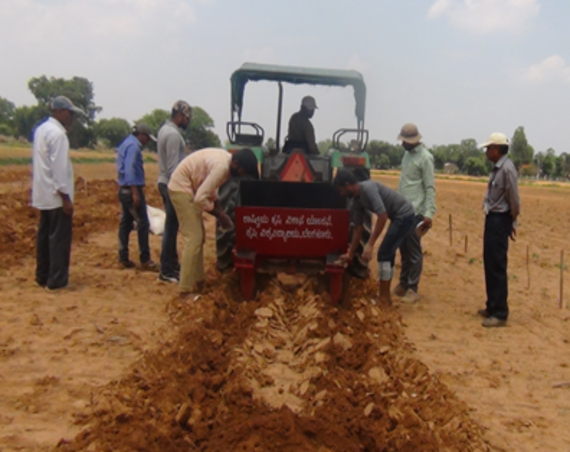Subsoil manuring for enhancing crop productivity in rainfed farming regions of southern Karnataka ha-1
-
Subsoil manuring is a new, novel soil management practice that has come from scientific research in the State of Victoria in Australia.
-
Subsoil manuring under Indian dry land conditions helps to develop the cost effective practice for Indian cropping systems particularly for Karnataka where more than 70% of the area is under dry land agriculture.
-
It is the first tangible practice that enables farmers to rapidly improve the productivity of clay enriched problematic subsoils specially in dryland sodic soils which have subsoil hardpans.
-
Experimental results of Subsoil manuring over two years in sodic soils on hybrid cotton and maize at KVK, Chamarajanagara and maize & red gram at farmer’s field, Purigaliin India, Karnataka state indicated that, deep ripping of sodic soils up to 45-50 cm and application of pressmud or poultry manure enriched with RDF (double the recommended dose of organic manures) at subsoil hard pan helped in improving the physical, chemical and biological properties of soil that reflected on improvement in the yield to an extent of 56 per cent compared to control where FYM and RDF were applied by conventional methods in these sodic soils.
-
The subsoil manuring demonstration results in sodic soil farmer’s field at Purigali village (10 acres) of Mandya district and KVK, Chamarajanagara (15 acres) indicated the yield improvement by 18 to 36 per cent compared to conventional cultivation where no ripping was done and no manure was applied to subsoil.
-
Even though the initial investment is high for the fabrication of ripper with manuring tank and high-power tractor ( >50 HP) requirement, this technology will significantly help in improving the salt-affected areas, specially sodic compacted subsoils of dryland areas of Southern dry zone of Karnataka, where, large areas are infested with sodicity problems which are left fallow without cultivation, as thereis no other alternate technology presently available to improve/reclaim this salt affected dry land sodicsoils.
-
Similarly, this technology is also very much useful for Alfisols having subsoil hardpan particularly in dry land areas where, the rainfall is the only source of water and the farmers are getting lower yields.In these areas this technology will help in enhancing the infiltration rate and storage of rain water in the root zone for the crop utilization.
Technology developed at UAS, Bangalore and given for package of practice
-
Technology of subsoil manuring was successfully demonstrated, which can be adopted anywhere in the country where subsoil hard pans / sodic hard pans are observed.
-
Subsoil manuring in dry land sodic soils having subsoil hardpan to be taken up immediately after 1st showers during May – June with recommended doses of fertilizers and double dose of organic manure (poultry manure or press mud or sheep manure) through sub soil ripper having manuring tank attached to tractor at 1 meter apart and at 45-50 cm depth. After getting good rains during monsoon season, crop to be taken which was decided earlier.
-
In the similar way next year also in the same field recommended dose of NPK for the crop to be grown along with double dose of organic manure should be applied through subsoil ripper at one meter apart between the earlier 1 meter ripper space to a depth of 45-50 depth. Then, after getting good rains in monsoon the crop decided earlier to be grown, so that the soil sodicity will be reduced, due to breaking of subsoil hardpan and adding organic manures, thereby water and nutrient holding capacity will be enhanced. Because of this soil fertility will be improved and can grow good crops in these soils in the coming years.
-
Similarly, in dryland alfisols having subsoil hardpan can be applied with poultry manure/sheep manure along with RDF, as explained above for sodic soils for two years will solve the problem of hardpan and helps in getting higher crop yields.

